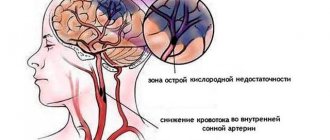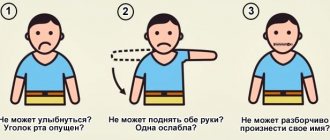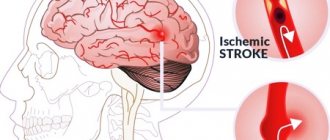What is transistorized ischemic attack?
Transistor ischemic attack (TIA) is a pathological condition in which blood circulation in the brain is disrupted. A characteristic feature of pathological disorders is their reversibility, which means that such processes do not cause irreversible brain damage.
TIA is often called a microstroke, but its difference from the latter is that the symptoms of a transistor ischemic attack disappear on their own within one hour. The duration of the attack varies - from a couple of minutes to several hours.
But the changes should be treated carefully, since after the first attack, as a rule, a second occurs, then a third, and then a stroke is not excluded.
This condition is a type of pathological circulatory disorder in the brain.
Transistor ischemic attack is a transient condition that does not provoke irreversible pathological changes.
The disease is more often diagnosed in older people - over 60 years old. In 60% of cases, the disease is not recognized in a timely manner. This is explained by the fact that many people do not pay due attention to their illness and do not consult a doctor.
In addition, TIA can occur during sleep. And since this condition does not provoke obvious consequences, the person simply does not know about it.
Causes of TIA
The obvious cause of a TIA is a blockage of a blood vessel that “delivers” blood to the brain, or a change in the blood supply to a certain area of the brain. Such pathological changes may be the result of an atherosclerotic plaque or blood clot.
Blood clots block the lumen of the vessel, which provokes problematic blood flow. As a result of the blockage, the area of the brain that was fed by this vessel stops receiving important nutrients.
The risk of developing a full-fledged stroke with corresponding changes is influenced by many factors: the diameter of the area of the blocked vessel, the area of the blockage of the vessel, the duration of the attack, etc.
Medicine knows of cases where the cause of the attack was a cerebral hemorrhage. But a feature of this type of disorder is that blood circulation is restored in a short time.
Some diseases of the cardiovascular system are also called causes of TIA:
- atherosclerosis;
- atrial fibrillation;
- infectious endocarditis;
- myocardial infarction;
- sick sinus syndrome;
- heart disease;
- aneurysm;
- atrial myxoma;
- artificial heart valve;
- significant blood loss.
The causes of transient ischemic attack and stroke are similar. But pathological changes have certain differences. With TIA, there is a short-term circulatory disorder, and all disorders are reversible.
Causes
The main causative diseases leading to the development of transient ischemic attacks are the following: atherosclerosis, hypertension, increased blood clotting and viscosity, cervical osteochondrosis, less commonly hypotension (for example, due to blood loss), diabetes mellitus, etc.
The direct cause of transient ischemic disorders in these diseases can be either a small blood clot, which the body’s anticoagulant system quickly “copes with”; or simply significant thickening of the blood with impaired blood flow; or prolonged spasm of one or more cerebral vessels.
Stress, emotional experiences, and bad habits also contribute to the development of this pathology.
Risk factors
Doctors have also identified factors that greatly increase the risk of attacks:
- age-related characteristics (pathological changes are more often observed in elderly patients);
- chronic hypertension;
- increased cholesterol levels;
- passion for smoking, alcohol;
- diabetes;
- chronic heart disease;
- obesity;
- passive lifestyle.
Pathogenesis
Transistor ischemic attack is characterized by pathological changes in cerebral blood flow. The completion of pathological disorders is the restoration of blood circulation in the ischemic area. All accompanying neurological signs are of a short-term, transient nature.
Ischemic stroke develops if at the previous stage (ischemic penumbra) there is no improvement in the blood supply to tissues damaged by ischemia. The provocateurs of ischemic stroke are worsening hypoxia and an increase in pathological changes in cerebral neurons.
Provoking risk factors
A number of factors can increase your chances of having a TIA. Some factors, such as age, gender, are fixed (unchangeable). However, others can be influenced. By making a number of lifestyle changes, the patient can reduce the risk of transient ischemic attack. See the Prevention section for more information on how this can be done.
Fixed risk factors
Some of the fixed risk factors associated with TIA are described below.
Age
As a person gets older, the arteries begin to narrow and the blood begins to thicken, increasing the risk of TIA. Most TIAs occur in people over 60 years of age, but transient ischemic attack can occur at any age, including children and young adults.
Floor
Men have a greater risk of TIA compared to women before menopause. However, the risk of TIA and stroke increases in postmenopausal women.
It is not entirely clear why a woman's risk of TIA increases after menopause. However, the female hormones estrogen and progesterone are thought to play a role as they can affect the elasticity of blood vessels. In menopausal women, estrogen and progesterone levels drop, which can cause blood vessels to become harder (i.e. less elastic).
Ethnos
South Asian, African, and Caribbean people have an increased risk of developing hypertension (high blood pressure) and diabetes, so they have an increased risk of TIAs.
Family history
If there is a family history of stroke or transient ischemic attack, the risk of the disease increases. However, the risk is relatively low, and having family members who have had a TIA does not necessarily mean you will have one.
Lifestyle Risk Factors
High blood pressure
High blood pressure (hypertension) is the most powerful risk factor associated with the disease. Hypertension puts extra stress on the blood vessels in the body, causing them to narrow or become clogged.
Weight and nutrition
A diet low in saturated fat increases the risk of developing atherosclerosis. If you have too much salt in your diet, it is likely that your blood pressure will be elevated, which, like atherosclerosis, is a major risk factor for TIA.
Overweight and obesity also strain the heart by weakening blood vessels.
Smoking
Smoking can double the risk of TIA and stroke. This is because the harmful chemicals in cigarette smoke cause the lining of the arteries to thicken, increasing the likelihood of blood clotting.
Stopping smoking is one of the main ways to prevent a TIA or stroke.
Diabetes
Type 1 diabetes can increase the risk of TIA. This is due to the fact that type 1 diabetes causes an increase in blood glucose levels, increasing the risk of developing atherosclerosis (the formation of fatty deposits in the blood vessels).
Classification of transient ischemic attacks
The symptoms of TIA depend on which vessels were changed by ischemia, and, accordingly, which part of the brain was damaged. In this regard, transistor ischemic attack is usually classified into the following types:
- disorders occurring in the vertebrobasilar region (VBB);
- disorders occurring in the carotid system.
Classification of TIA by frequency:
- rare - up to 2 times/year;
- average - up to 6 times/year;
- frequent - up to 12 or more times within 12 months.
Classification of TIA by severity:
- mild - symptoms appear within 10 minutes;
- medium - symptoms persist for up to several hours;
- severe - TIA lasts from 12 to 24 hours.
TIA classification
Depending on the severity of the clinical course, the following options are distinguished:
- mild course (symptoms last no more than 10 minutes and regress). Most often, with this course, patients do not seek medical help and do not attach any significance to this episode of ischemia. The drama of the situation lies in the fact that this episode is not the last and after some time will manifest itself as a full-blown stroke;
- moderate severity (symptoms are observed for several hours);
- severe course (symptoms persist throughout the day). This TIA must be differentiated from a stroke.
Depending on the frequency of occurrence, the following TIAs are distinguished:
- single (no more than 2 times a year);
- medium frequency (3-6 times a year);
- frequent (more than once a month).
Symptoms of pathological changes
A common type of TIA is pathological abnormalities occurring in the VS (70% of cases). In corresponding attacks, the patient exhibits the following symptoms:
- dizziness with attacks of headache (aching or sharp) in the back of the head;
- speech disorder;
- deterioration of visual function;
- nausea turning into vomiting;
- change in coordination of movements;
- hearing impairment;
- fainting;
- numbness of the mouth area;
- paresis of one half of the face.
Signs of carotid TIA:
- impaired coordination of movements;
- changes in vision (blindness, double vision);
- paresis of one area of the body (hands, face, etc.);
- loss of sensation in fingers and toes;
- change in facial skin sensitivity.
TIA symptoms
One of the signs of TIA is severe dizziness with nausea.
As with a stroke, the symptoms of TIA depend on the localization of the ischemic process, i.e., on which arterial basin the ischemia occurred. In general, the following symptoms are distinguished:
- speech impairment or slurred speech;
- nausea, especially if accompanied by vomiting;
- intense dizziness;
- numbness of the face;
- short-term visual impairment;
- temporary motor and sensory disturbances;
- disorientation in place, space and self.
Ischemia in the carotid region is manifested by hemispheric symptoms. The patient will present the following complaints:
- sudden sharp decrease in vision or blindness in one eye within a few minutes;
- optic-pyramidal syndrome (reduced vision or blindness combined with weakness in the opposite limbs);
- brachiofacial paresis (smoothness of the nasolabial fold and numbness of the hand on the opposite side);
- cortical dysphasia (speech impairment).
Ischemia in the vertebrobasilar arterial system occurs with cerebellar-stem symptoms. The patient will have the following complaints:
- severe dizziness, which is accompanied by nausea and vomiting, unsteady gait. The patient appears drunk;
- the patient sees blurredly, the image is double;
- unclear speech, possible difficulty swallowing;
- photopsia in both eyes;
- nystagmus (quivering eyelids).
There are some conditions that produce similar symptoms to TIAs. These include:
- comatose states with diabetes mellitus;
- epileptic seizures;
- migraine attack with aura;
- transient global amnesia;
- debut of multiple sclerosis;
- Meniere's disease.
Diagnosis of TIA
If pathological changes appear, it is recommended to immediately consult a doctor. If you suspect a TIA, you should consult a cardiologist, neurologist and ophthalmologist.
Since the symptoms of transient ischemic attack are short-lived, the disease is diagnosed based on an examination of the patient, his medical history and neurological status.
To identify the cause of pathological disorders and assess the risk of stroke, the doctor prescribes the following diagnostic measures to the patient:
- clinical examination (measurement of blood pressure, blood test, urine test, blood test for cholesterol, glucose, etc.);
- hardware examination (ECG, CT or MRI of the brain, X-ray of the lungs, angiography, daily monitoring of blood pressure, pulse oximetry).
Diagnostics
If symptoms of a transient ischemic attack occur, you should seek medical help immediately. This will minimize the risk of further TIAs or strokes.
Initial assessment
TIAs often end very quickly, so there may be no symptoms left by the time a person sees a GP or other healthcare professional.
When you are examined, your healthcare professional will ask you in detail about the symptoms you had during the attack. For example, they will need to know how long the symptoms lasted and how they affected you. This will help rule out other conditions that could be causing your symptoms.
Your physician or health care provider may still need to examine you neurologically even if you feel your symptoms have resolved. You will have to complete a series of simple tasks to test your skills such as strength, sensation, coordination.
Directions
If your GP suspects there has been a temporary cerebrovascular accident, you may be referred to a cardiologist , geriatrician, neurologist (a doctor who specializes in treating diseases of the brain and spine), or a consultant who specializes in stroke. Some people may be referred to a specialist TIA clinic.
The patient should be referred to a specialist or TIA clinic within 7 days of the first attack. If there has been more than one episode of TIA within 7 days, the person should be seen by a specialist immediately.
Surveys
After a TIA, a series of examinations are prescribed to check for any underlying factors or conditions that triggered the mini-stroke. Some of these tests are listed below.
Blood tests
If there has been a transient ischemic attack, a series of blood tests may be required, including:
- blood pressure - the first thing that will be checked is your blood pressure, as high blood pressure (hypertension) is a major risk factor for TIA;
- blood clotting test - a comprehensive analysis of blood clotting indicators is carried out to check how “thin” the blood is and how high the likelihood of blood clotting is;
- Cholesterol testing —a serum cholesterol test can be used to check your cholesterol levels; if there is a high level of cholesterol, the patient is at greater risk of developing TIA, stroke;
- Glucose test - the level of glucose (sugar) in the blood will be checked. High blood glucose levels may indicate that the patient has diabetes.
Treatment methods
Therapy for TIA should be prescribed to the patient as early as possible. Patients with symptoms of cerebral circulatory disorders should be urgently hospitalized. As a rule, the patient is admitted to the intensive care unit, where he receives emergency medical care.
For TIA, bed rest and blood pressure monitoring are required. To normalize blood pressure and eliminate fluctuations in its indicators, a group of medications is prescribed:
- ACE inhibitors;
- beta blockers;
- calcium channel blockers;
- vasodilators;
- diuretics.
Other medications are also prescribed together with the main drugs:
- antiplatelet agents (prevention of stroke);
- indirect anticoagulants (indicated for atrial fibrillation);
- statins (lowering cholesterol levels);
- neuroprotectors (protection and improvement of brain nutrition);
- insulin (for patients with diabetes).
Physiotherapy (only on doctor's recommendation):
- balneotherapy (salt, pine, radon baths);
- electrophoresis;
- microwave therapy;
- magnetotherapy.
In some cases, surgical treatment is indicated for TIA (for frequent and prolonged attacks). During surgery, the patient has fat that is “pinching” an artery removed or a damaged part of a blood vessel is removed. Another method of surgical treatment for TIA is angioplasty.
In most cases, patients who have already suffered a TIA seek medical help. In this case, the treatment method is aimed at preventing complications, and not at eliminating pathological signs.
Forecast
Pathological changes in TIA are reversible. But this condition must be taken as seriously as possible. The prognosis for TIA is favorable, but attacks are often precursors to a stroke.
Medical statistics show that 8% of patients after a TIA develop a stroke within a month. In 12% of patients, a stroke was diagnosed within a year after the TIA. And in 29% of patients, complications occurred within 5 years after transistor ischemic attack.
Prevention of transient ischemic attack
The basis of preventive measures is the elimination of provoking factors. The risk of developing TIA is significantly reduced if a person eats healthy food, watches his weight, exercises, and does not abuse smoking or drinking alcoholic beverages.
People who have suffered at least one transistor ischemic attack need to regularly visit their doctor, as well as periodically undergo appropriate tests to monitor cholesterol levels, blood clotting indicators and blood pressure.
Self-treatment of transistor ischemic attacks is unacceptable. Lack of timely qualified therapy increases the risk of developing more serious complications (stroke).










